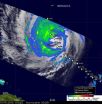(Press-News.org) The Moderate Resolution Imaging Spectroradiometer or MODIS, is an instrument that flies on NASA's Aqua and Terra satellites and provides incredible views of tropical cyclones like Hurricane Igor, from its vantage point in space. Imagery from the MODIS instruments on these two satellites captured from Sept. 18 to 20 showed that powerful Hurricane Igor in the Atlantic Ocean is morphing from a rounded storm to more of a comma-shaped storm.
The MODIS instrument on NASA's Terra satellite captured a visible image of Igor at 11:30 am on Sept. 18, while MODIS in the Aqua satellite captured Igor's center just southwest of Bermuda on Sept. 19 at 1:30 p.m. EDT. In imagery on both days, Hurricane Igor maintained a rounded shape and its eye was cloud-filled. When the MODIS instrument that flies aboard NASA's Terra satellite captured Igor after it passed Bermuda on Sept. 20 at 11:15 a.m. EDT, the imagery showed the Igor appeared elongated from south to north, and more resembled a comma-shape. There was even an eye visible in the latest image.
The Atmospheric Infrared Sounder Instrument (AIRS) that flies on NASA's Aqua satellite captured infrared images of Hurricane Igor's cold cloud temperatures and cloud cover on Sept. 18, Sept. 19, and Sept. 20. Igor lost its circular shape by Sept. 20, and there were very few high, strong thunderstorms where the cloud tops were colder than -63F. Infrared data from AIRS on Sept. 20 indicated that Igor was losing its strength as the cloud tops in the thunderstorms within were warming (less high in the atmosphere) and waning.
NASA and JAXA's Tropical Rainfall Measuring Mission (TRMM) satellite also continues to fly over Igor as he makes his track northward in the Atlantic Ocean.
Hurrricane Igor continued to weaken as the Tropical Rainfall Measuring Mission (TRMM) satellite passed over on September 19, 2010 at 0144 UTC showing that the hurricane no longer had an eye. Igor's wind speeds had decreased to about 75 knots (~86 mph) when TRMM collected the TRMM Microwave Imager (TMI) data used in the precipitation analysis. TRMM is managed by both NASA and the Japanese Space Agency.
By 2p.m. EDT on Sept. 20, all warnings and watches for Bermuda had been discontinued. Igor had moved about 350 miles north-northeast of Bermuda and was headed into the North Atlantic. It was located near 37.1 North and 62.5 West. Now, a tropical storm watch is in effect for the coast of Newfoundland from Stones Cove northward and Westward to Jones Harbour, Canada.
Igor was just barely a hurricane, with maximum sustained winds near 75 mph. It was moving northeast at 26 mph. Its minimum central pressure was 965 millibars.
Large swells will continue to affect Bermuda and the U.S. East coast through Tuesday, Sept. 21, causing life-threatening rip-currents and rough surf. Swells affecting the Lesser Antilles, the Virgin Islands, Puerto Rico, Hispaniola and the Bahamas will subside over the next couple of days.
INFORMATION:
NASA's MODIS and AIRS instruments watch Igor changing shape, warming over 3 days
2010-09-21
ELSE PRESS RELEASES FROM THIS DATE:
Food for thought, er, well...
2010-09-21
Ever wonder why it's such an effort to forget about work while on vacation or to silence that annoying song that's playing over and over in your head?
Mathematicians at Case Western Reserve University may have part of the answer.
They've found that just as thinking burns energy, stopping a thought burns energy - like stopping a truck on a downhill slope.
"Maybe this explains why it is so tiring to relax and think about nothing," said Daniela Calvetti, professor of mathematics, and one of the authors of a new brain study. Their work is published in an advanced online ...
Low-calorie cheesecake? Why we have trouble estimating calories
2010-09-21
When it comes to estimating calorie counts, Americans aren't really on the ball. According to a new study in the Journal of Consumer Research, this may be because of the order in which we encounter the food.
"The sequence in which items are considered often influences our evaluations of these items," writes author Alexander Chernev (Northwestern University). "The focus on sequential estimation is important because many meals are ordered and consumed sequentially rather than at once. Moreover, to control their daily calorie intake, people often estimate not only the amount ...
Santa Fe homeowners weigh in on landscape preferences
2010-09-21
LAS CRUCES, NM—While municipalities may mandate communitywide water conservation measures, individuals—particularly homeowners—can make significant contributions to water conservation in urban environments. Hoping to provide urban planners with more information about how residents' landscape preferences affect municipal water supplies, a team from New Mexico State University surveyed homeowners in Santa Fe about their attitudes toward high desert plants. Rolston St. Hilaire, Dawn M. VanLeeuwen, and Patrick Torres reported on their study of residents' preferences for urban ...
Scientists uncover process enabling toxoplasmosis parasite to survive homelessness
2010-09-21
INDIANAPOLIS — The parasite responsible for toxoplasmosis requires a stress response system that helps it survive the move to infect new cells, Indiana University School of Medicine scientists have reported, a discovery that could lead to new treatments to control the disease.
Parasites such as Toxoplasma gondii invade host cells, replicate and then must exit to find new host cells to invade. Traveling outside their host cell exposes the parasites to environmental stresses that limit how long they can remain viable while searching for new host cells.
The researchers ...
Learning how consumers value products
2010-09-21
Suggesting to consumers that they will use a product frequently can actually reduce their interest in purchasing the product, according to a new study in the Journal of Consumer Research.
"When consumers estimate the value of a durable product, they consider not only the absolute number of times they think they will use the product, but also the number of time they will use the product relative to other consumers," write authors Rebecca W. Hamilton, Rebecca K. Ratner (both University of Maryland, College Park), and Debora Viana Thompson (Georgetown University).
The ...
Could learning self-control be enjoyable?
2010-09-21
When it comes to self-control, consumers in the United States are in trouble. But a new study in the Journal of Consumer Research says there's hope; we just need a little help to see self-regulation as fun.
"Self-control failures depend on whether people see activities involving self-control (e.g., eating in moderate quantities) as an obligation to work or an opportunity to have fun," write authors Juliano Laran (University of Miami) and Chris Janiszewski (University of Florida, Gainesville).
According to the authors, approximately one in five U.S. citizens over the ...
Windborne dust on high peaks dampens Colorado River runoff
2010-09-21
On spring winds, something wicked this way comes--at least for the mountains of the Colorado River Basin and their ecosystems, and for people who depend on snowmelt from these mountains as a regional source of water.
"More than 80 percent of sunlight falling on fresh snow is reflected back to space," says scientist Tom Painter of the Jet Propulsion Laboratory in Pasadena, Calif., and the University of California at Los Angeles. "But sprinkle some dark particles on the snow and that number drops dramatically."
The darker dust absorbs sunlight, reducing the amount of ...
Buyer backlash: Why do slogans about saving money increase spending?
2010-09-21
A new study in the Journal of Consumer Research reveals a strange facet of consumer behavior: people behave differently when they encounter companies' brands than they do when they encounter their slogans.
"Exposure to the retailer brand name Walmart, typically associated with saving money, reduces subsequent spending, whereas exposure to the Walmart slogan, (Save money. Live better.) increases spending," write authors Juliano Laran (University of Miami), Amy N. Dalton (Hong Kong University of Science and Technology), and Eduardo B. Andrade (University of California, ...
Money, drugs and chicken feet? What consumers will do for social acceptance
2010-09-21
People who feel excluded will go to any length to try to become part of a group, even if it involves spending large sums of cash, eating something dicey, or doing illicit drugs, according to a new study in the Journal of Consumer Research.
"Social exclusion prompts people to use money and consumption in the service of affiliation," write authors Nicole L. Mead (Tilburg University), Roy F. Baumeister (Florida State University), Tyler F. Stillman (Southern Utah University), Catherine D. Rawn (University of British Columbia), and Kathleen D. Vohs (University of Minnesota).
"An ...
Hard-wired for chocolate and hybrid cars? How genetics affect consumer choice
2010-09-21
Clues to consumer behavior may be lurking our genes, according to a new study in the Journal of Consumer Research.
"We examine a wide range of consumer judgment and decision-making phenomenon and discover that many—though not all of them—are in fact heritable or influenced by genetic factors," write authors Itamar Simonson (Stanford University) and Aner Sela (University of Florida, Gainesville).
The authors studied twins' consumer preferences to determine whether or not certain behaviors or traits have a genetic basis. "A greater similarity in behavior or trait between ...



